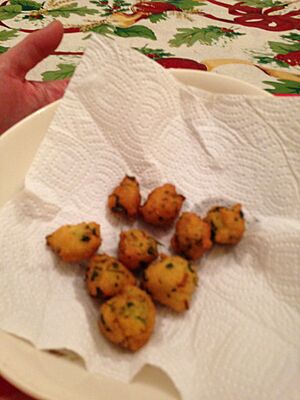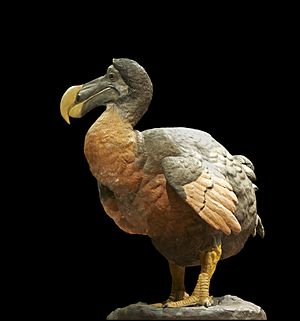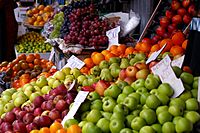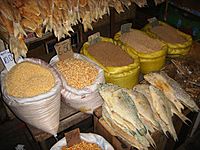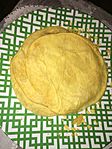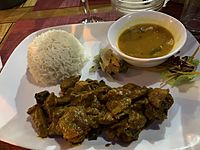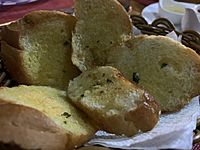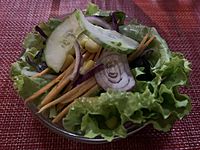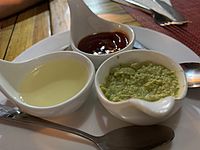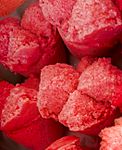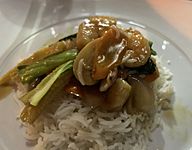Mauritian cuisine facts for kids
The cuisine of Mauritius is a delicious mix of flavors from different cultures! Because the island of Mauritius is in the tropics, it has many fresh ingredients. Over time, people from Africa, China, Europe (especially France), and India came to Mauritius. They brought their cooking styles with them.
These different cultures shared and mixed their recipes, creating the unique food we call Mauritian cuisine today. While some dishes are loved by everyone, certain foods are special to specific groups because of their history.
French dishes are very popular in Mauritius. You'll also find many restaurants serving Sino-Mauritian food across the island.
Contents
What Ingredients Are Common in Mauritian Food?
Mauritian cooking uses lots of fresh vegetables. Some common ones are tomatoes, onions, lady's finger (called "lalo"), eggplants ("brinzel"), chayote ("chou chou"), garlic, and chillies.
Rice is a main food here. People also eat a lot of seafood. This includes salted fish, smoked blue marlin, shrimp, octopus, prawns, and crayfish ("camaron").
Spices like chilli peppers, cardamon, and cloves are used a lot to give food amazing flavor.
Popular Mauritian Dishes
Main Foods in Mauritius
Rice is a very important food in Mauritius. It can be fried, boiled, or cooked with spices. People eat rice with dishes made from vegetables, meat, and seafood.
Common Main and Side Dishes
Many dishes are popular with all Mauritians. These include Chinese noodles (fried or boiled), fried rice ("diri frir"), "bol renversé", and "boulettes" (like fish, vegetable, or meat balls in broth). You'll also find Sino-Mauritian spring rolls, Chop seuy, haleem ("halim"), and "bryani".
Dholl puri and roti are often served with tomato sauce and pickles. Curries, including "sept caris" (Tali), are also very popular. Another well-known dish is "vinnday" (or "vindaye"). A spicier version of vinnday uses vinegar, mustard seeds, and turmeric.
Mauritius is famous for its sauces and curries. These are usually served with meat, seafood, and vegetable dishes. Other common sides are chutney, archard, and pickles. Mauritian curries are special because they rarely use coconut milk. They often include European herbs like thyme and different meats like duck or octopus.
The rougaille (or "rougay") is a popular tomato sauce. It's cooked with onions, garlic, chillies, ginger, and various spices. You can eat it with fish, meat, or vegetables. Mauritian versions of curry, chutney, rougaille, and pickles have their own local taste. They can be quite different from the original Indian recipes.
Popular Snacks in Mauritius
Mauritius has many tasty snacks!
- Gato Brinzel (Eggplant cake) is a popular snack that came from India.
- Gateau Patates (Sweet potato cake) is a small, crescent-shaped cake. It's made from boiled sweet potato, flour, and sugar. The dough is filled with grated coconut and sugar, then deep-fried.
- Gato Piment (Chilli cake) are Mauritian chilli fritters. These cakes are made from split-peas mixed with chilli. They are a very popular snack.
- Merveilles are a popular street food. People eat them with "satini" (a type of chutney) or "mazavarou" (a red chilli sauce).
- Samosas are also a popular snack in Mauritius.
Delicious Desserts and Pastries
Mauritius offers many sweet treats:
- Biscuit Manioc is a popular dessert across different communities. It's made of flavored manioc biscuit cookies mixed with fresh fruits and ice cream.
- Glaçon rapé is a popular ice cream. It's made of shaved ice mixed with different syrup flavors like vanilla, strawberry, almond, and pineapple.
- Napolitaine is a local pastry. It's made of two sablé biscuits with jam in between, all covered in sugar. Even though it has a French name, it started in Mauritius.
- "Poudine maïs" (corn pudding), also known as polenta pudding, is a sweet dessert. It's often eaten as a snack with tea. The Creole community is especially known for their corn pudding.
Common Drinks in Mauritius
Popular Non-Alcoholic Drinks
- Alouda is a sweet, cold drink. It's made with milk, basil seeds ("tukmaria"), and colorful slices of agar-agar jelly. It's super refreshing on a hot day! You can find it in flavors like almond or vanilla.
- Coffee is a very common drink. Coffee is grown right there in Mauritius.
- Mousse Noir literally means "black jelly." It's a cold Chinese drink made from grass jelly in water with sugar or syrup.
- Panacon is a cold drink made for religious ceremonies like cavadee. It's made with tamarind, sugar, lemons, and cardamon.
- Tea is also very common. Mauritians drink a lot of tea, especially black tea. Tea is grown locally in Mauritius, and often flavored with vanilla.
- Bois Chérie tea is a popular local tea brand.
- Bubble tea shops started opening in Mauritius in late 2012. Now, you can find them in most shopping malls. They've become a popular spot for teenagers to hang out.
History of Mauritian Food: Where it Came From
Dutch Influences
The Dutch were in Mauritius from 1598 to 1710. They brought sugarcane from Java to the island. At first, sugarcane was mostly used to make arrack, which was an early form of rum. It took another 60 years before sugar, as we know it, was made.
In 1639, deer from Java were brought to Mauritius by the Dutch governor. After a cyclone, the deer escaped and lived in the wild.
The Dodo Bird and Its Fate
When Mauritius was first discovered, it was home to a unique bird called the dodo. Dodos were related to pigeons and had lived on the island for millions of years without predators. Because they had no enemies, they lost the ability to fly.
In 1505, the Portuguese were the first humans to arrive. Mauritius became a stop for ships trading spices. Dodos, weighing up to 50 pounds, were an easy source of fresh meat for sailors. Many dodos were hunted for food.
Later, when the Dutch used the island as a prison colony, new animals were brought in. Rats, pigs, and monkeys ate dodo eggs from their ground nests. The combination of hunting by humans and new animals eating their eggs quickly reduced the dodo population. Within 100 years of humans arriving, the dodo became very rare. The last one was killed in 1681. The dodo is now a symbol of Mauritius and is on the coat of arms of Mauritius.
French and British Influences
French Flavors in Mauritian Food
Mauritius has always had strong connections to French culture. French traditions, like hunting, also influenced Mauritian food. You can find dishes like venison (deer meat) and wild boar, often served in fancy restaurants. Over time, these dishes were changed to use the island's unique ingredients.
French influences are seen in dishes like Rougailles (a light stew) with thyme, Daube (chicken or beef stew), croissants, baguette bread, bouillon, tuna salad, civet de lièvre, and coq au vin. Many French desserts and cakes, like tarts, are also popular. Franco-Mauritians especially enjoy French tarts and milk coffee.
British Influences in Mauritian Food
The British took over Mauritius in 1810. They brought with them the tradition of afternoon tea. This is why having tea in the afternoon is still popular in Mauritius today.
Chinese Flavors in Mauritian Food
Sino-Mauritian food includes both traditional Chinese dishes and Chinese dishes that have been changed to fit Mauritian tastes. This cuisine often features fried vegetables, oyster sauce, fried rice, meat, and fish.
In the 1800s, Chinese migrants arrived in Mauritius, mostly from southeastern China. They lived peacefully in Chinatown in Port Louis and shared their culture. They are known for making noodles (steamed and fried) and fried rice popular. Sino-Mauritians also keep some Chinese food traditions. For example, they share Chinese red eggs with family. It's also a custom to eat fried noodles for birthday celebrations.
In recent years, some Sino-Mauritians who lived in China or Taiwan came back to Mauritius. They brought new Chinese dishes and drinks. For instance, Bubble tea was introduced by Fabrice Lee, who lived in Taiwan for eight years. The first bubble tea shop opened in late 2012, and now they are popular spots for teenagers in shopping malls.
Sino-Mauritian food includes many appetizers, pastries, snacks, and main dishes. Some popular ones are:
- Appetizers like "Dizef roti" (roasted eggs) and "Hakien" (a local spring roll).
- Pastries like Almond biscuits, Fa gao, Jian dui (sesame balls), and Mooncakes.
- Dim sum-like dishes called "Boulettes," which include fish balls, meat balls, and siumai.
- Main dishes like different types of Chinese noodles ("mines") and various rice dishes like "Bol renversé" and fried rice.
- Side dishes such as Chop suey and different chicken, duck, beef, and fish dishes.
- Soups like Chinese corn soup and fish ball soup.
- Drinks like Bubble tea and Mousse noir.
Many traditional Sino-Mauritian dishes are also eaten during important Chinese holidays:
- For Chinese New Year, people eat Chipeks, Fa gao, "gato crab," "gato cravat," Sachima, Nian gao, Jian dui, and "Tao Sa."
- For Lantern Festival, they eat Tangyuan.
- For Dragon Boat Festival, they eat zongzi.
- For Guan Di Birthday, also called "Fete Mines," people eat Fried Noodles.
- For Mid-Autumn Festival, they enjoy mooncakes.
You can find Chinese and other Asian restaurants all over the island. They offer many chicken, squid, beef, and fish dishes, often cooked with black bean sauce or oyster sauce.
Indian Flavors in Mauritian Food
After slavery ended, Indian workers came to Mauritius in the 1800s. They brought their own cooking traditions from different parts of India. So, you can find both northern and southern Indian food styles in Mauritius. Because Indian Mauritians are the largest group, they helped make rice the main food.
Dholl-puri and roti, which came from India, are now popular foods for everyone in Mauritius.
Indo-Mauritian cooking uses common ingredients like dals (like yellow-split peas), vegetables, beans, and pickles. It also uses many spices, such as saffron, cinnamon, cardamon, and cloves.
Some popular Indian-Mauritian foods include:
- Yellow-split peas dishes like Dholl puri, a flat pancake stuffed with yellow split peas, served with tomato sauce and pickles.
- Flour-based foods like Roti, Chapattis, and Farata.
- Rice-based dishes like Byriani, a popular street food often made by the Muslim community.
- Side dishes like Curry ("carri"), which are very important in Mauritian curries. "Sept-caris" (Thali) is traditionally served at Indian weddings.
- Pickles, including vegetable archard made with shredded cabbage, carrots, beans, and cauliflowers.
- Snacks like Ghantia, Gâteau piments (chilli cakes), Gato brinzel (eggplant cakes), Poutou, and Samosas.
- Sweets like Gulab jamun, Rasgulla, and Sultalfine.
- Condiments like Chutney ("satini"), including chilli-coconut chutney.
Mauritian Creole Cuisine
Creole cuisine is enjoyed by all Mauritians. It's a mix of African, Indian, and French cooking styles. Mauritian Creole dishes often use seafood, fresh vegetables, pulses (like lentils), beans, and corn.
Some Creole dishes include:
- Creole rougaille is a spicy tomato sauce with meat or fish, showing its African roots.
- Plain rougaille is a simple tomato rougaille that can be a side dish.
- Vindaye is deep-fried fish coated in a mix of turmeric, mustard seeds, ginger, and chillies. Octopus can also be used, but it's blanched instead of fried.
- Poudine Mais (Corn pudding) is a well-known dessert of the Mauritian Creole community.
How Food and Drink Industries Grew
The Story of Tea in Mauritius
Tea plants were first brought to Mauritius in 1760 by a French priest. In 1770, Pierre Poivre planted tea on a larger scale. However, it was in the 1800s, when the British ruled, that growing tea for business really started. Robert Farquhar, a governor, had a tea garden. Later, another governor, Sir John Pope Hennessy, helped bring back interest in tea farming. New tea plantations were started at Nouvelle France and Chamarel.
Famous Mauritian Chefs
- Madeleine Parent is one of the most famous chefs in Mauritian cuisine. Her book, Best of Mauritian Cuisine, won a "Best in the World" award in 2018!
Images for kids
-
Foods at Port Louis Central Market


